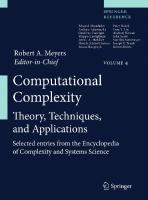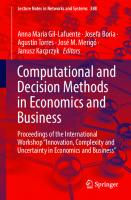Aspects of Complexity: Minicourses in Algorithmics, Complexity and Computational Algebra. Mathematics Workshop, Kaikoura, January 7-15, 2000 [Reprint 2010 ed.] 9783110889178, 9783110168105
The book contains 8 detailed expositions of the lectures given at the Kaikoura 2000 Workshop on Computability, Complexit
187 49 22MB
English Pages 178 [180] Year 2001
Preface
Basic complexity
Three lectures on real computation
Parameterized complexity: new developments and research frontiers
Kolmogorov complexity
Complexity and computation in matrix groups
The complexity of counting problems
The Ω conjecture
List of contributors
Recommend Papers
![Aspects of Complexity: Minicourses in Algorithmics, Complexity and Computational Algebra. Mathematics Workshop, Kaikoura, January 7-15, 2000 [Reprint 2010 ed.]
9783110889178, 9783110168105](https://ebin.pub/img/200x200/aspects-of-complexity-minicourses-in-algorithmics-complexity-and-computational-algebra-mathematics-workshop-kaikoura-january-7-15-2000-reprint-2010nbsped-9783110889178-9783110168105.jpg)
- Author / Uploaded
- Rod Downey (editor)
- Denis R. Hirschfeldt (editor)
File loading please wait...
Citation preview
de Gruyter Series in Logic and Its Applications 4 Editors: W. A. Hodges (London) · R. Jensen (Berlin) S. Lempp (Madison) · M. Magidor (Jerusalem)
Aspects of Complexity Minicourses in Algorithmics, Complexity and Computational Algebra Mathematics Workshop, Kaikoura, January 7-15, 2000
Editors
Rod Downey Denis Hirschfeldt
W DE
G
Walter de Gruyter Berlin · New York 2001
Editors Denis Hirschfeldt Department of Mathematics University of Chicago Chicago, IL 60637 USA
Rod Downey School of Mathematical and Computing Sciences Victoria University PO Box 600, Wellington New Zealand
Series Editors Wilfrid A. Hodges School of Mathematical Sciences Queen Mary and Westfield College University of London Mile End Road London El 4NS, United Kingdom
Ronald Jensen Institut für Mathematik Humboldt-Universität Unter den Linden 6 10099 Berlin, Germany
Steifen Lempp Department of Mathematics University of Wisconsin 480 Lincoln Drive Madison, WI 53706-1388, USA
Menachem Magidor Institute of Mathematics The Hebrew University Givat Ram 91904 Jerusalem, Israel
Mathematics Subject Classification 2000: 03-06; 03D15, 03D20, 68Q05, 68Q15, 68Q17, 68Q19, 68Q25, 68Q30, 68Q45 ©
Printed on acid-free paper which falls within the guidelines of the ANSI to ensure permanence and durability
Library of Congress — Cataloging-in-Publication Data
Aspects of complexity : minicourses in algorithmics, complexity and computational algebra, mathematics workshop, Kaikoura, January 7-15, 2000 / editors Rod Downey, Denis Hirschfeldt p. cm. - (De Gruyter series in logic and its applications, 4) ISBN 3-11-016810-3 (cloth : alk. paper) 1. Computational complexity - Congresses. I. Downey, R. G. (Rod G.) II. Hirschfeldt, Denis Roman. III. Series. QA267.7 A87 2001 511.3-dc21 2001047182
Die Deutsche Bibliothek — Cataloging-in-Publication Data Aspects of complexity : minicourses in algorithmics, complexity and computational algebra / Mathematics Workshop, Kaikoura, January 7-15, 2000. Ed. Rod Downey ; Denis Hirschfeldt. - Berlin ; New York: de Gruyter, 2001 (De Gruyter series in logic and its applications ; 4) ISBN 3-11-016810-3 ISSN 1438-1893 © Copyright 2001 by Walter de Gruyter GmbH & Co. KG, 10785 Berlin, Germany. All rights reserved, including those of translation into foreign languages. No part of this book may be reproduced in any form or by any means, electronic or mechanical, including photocopy, recording, or any information storage and retrieval system, without permission in writing from the publisher. Printed in Germany. Typesetting using the Authors' TgX files: I. Zimmermann, Freiburg - Printing and binding: Hubert & Co. GmbH & Co. KG, Göttingen - Cover design: Rainer Engel, Berlin.
Preface
The New Zealand Mathematical Sciences Research Institute was formed to promote mathematical and information sciences in New Zealand. Its directors are Marston Conder, Rod Downey, David Gauld, Vaughan Jones, and Gaven Martin. With the generous support of the Marsden Fund for basic science in New Zealand, each year the institute holds a summer workshop devoted to a particular area of mathematics in some out-of-the-way part of New Zealand. The material is specifically aimed at beginning graduate students. Previous meetings have been held in Huia (1994), Tolaga Bay (1996, 1997), Napier (1998), and Raglan (1999). For the first time, on January 7-15,2000, the workshop was held in the South Island, at beautiful Kaikoura. The topic for Kaikoura 2000 was "Computability, Complexity, and Computational Algebra". The number of attendees was roughly double that of any previous meeting, with over 150 people associated with the group, including families. We were fortunate to have a fine group of speakers, all of whom are world-renowned mathematicians and computer scientists. Each of the speakers gave a series of 1-3 lectures, at least the first two being easily accessible to graduate students. Our speakers were, in no particular order: • Dominic Welsh (Oxford) on Enumeration Complexity (3 lectures), • Lance Fortnow (NEC Research Institute) on Kolmogorov Complexity (3 lectures), • Eric Allender (Rutgers) on Basic Complexity (3 lectures), • Hugh Woodin (Berkeley) on The Continuum Hypothesis (1 lecture), • Mike Fellows (University of Victoria, BC, and Victoria University of Wellington) on Parameterized Complexity, Treewidth, and the Like (3 lectures), • Felipe Cucker (Hong Kong) on Real Complexity (3 lectures), • Elwyn Berlekamp (Berkeley) on Games (3 lectures), • Persi Diaconis (Stanford) on Randomized Algorithms (3 lectures), • Alice Niemeyer (Western Australia) on Computation in Matrix Groups ( 1 lecture), and • Cheryl Praeger (Western Australia) on Complexity and Computation in Matrix Groups (2 lectures). This volume represents the mathematical proceedings of Kaikoura 2000. All of the articles are based on the actual lectures given, and in the cases of Allender, Fortnow,
vi
Preface
and Welsh, were prepared from notes by graduate students Amy Gale (Fortnow and Welsh) and Catherine McCartin (Allender). It is often hard to find insightful short courses that lead the reader to modern research but are aimed at the graduate student rather than the "professional mathematician". We hope that the articles in this volume will serve this purpose. Wellington, December 2000
Rod Downey and Denis Hirschfeldt
Table of contents
Preface
v
Eric Allender and Catherine McCartin Basic complexity
1
Felipe Cucker Three lectures on real computation
29
Michael R. Fellows Parameterized complexity: new developments and research frontiers
51
Lance Fortnow Kolmogorov complexity
73
Alice C. Niemeyer and Cheryl E. Praeger Complexity and computation in matrix groups
87
Dominic Welsh and Amy Gale The complexity of counting problems
115
W. Hugh Woodin The Ω conjecture
155
List of contributors
17 ί
Basic complexity Eric Allender* and Catherine McCartin**
Abstract. This paper summarizes a series of three lectures the first author was invited to present at the NZMRI summer 2000 workshop, held in Kaikoura, New Zealand. Lecture 1 presents the goals of computational complexity theory. We discuss (a) what complexity provably can never deliver, (b) what it hopes to deliver but thus far has not, and finally (c) where it has been extremely successful in providing useful theorems. In so doing, we introduce nondeterministic Turing machines. Lecture 2 presents alternation, a surprisingly-useful generalization of nondeterminism. Using alternation, we define more complexity classes, and inject clarity into a confusing situation. In Lecture 3 we present a few of the most beautiful results in computational complexity theory. In particular, we discuss (a) the algebraic approach to circuit complexity, (b) circuit lower bounds, and (c) derandomization.
Lecture 1 Warning: This brief survey cannot take the place of a comprehensive textbook. Readers looking for a more detailed account of the topics introduced here may wish to consult books such as [HU79, BDG95, BDG90, Vol99, Pap94, DKOO] or survey chapters such as [ALR99, BS90]. To illustrate what we would like complexity theory to do, it may be best to start by considering a "dream result" that complexity theory cannot prove (yet). Consider the following elusive goal, currently far beyond our capabilities. Prove: Any circuit of NAND gates that will factor 600 digit numbers must have > 2100 gates. If this could be proved, surely it would place public-key cryptography on a firm foundation, and would show that factoring is hard with any computing technology. Or would it? Note that factoring is easy using "quantum circuits" [Sho97]. This example forces us to consider the following questions: * Supported in part by NSF grant CCR-9734918. **This paper was prepared from notes taken by the second author of the first author's lectures at Kaikoura 2000.
Eric Allender and Catherine McCartin Are any functions this complex? Answer: Yes! Just count. The number of functions on 600 bits is exactly 22 . A circuit of size 2100 can be described in 300 χ 2100 bits. Thus, the number of functions with circuits of size 2100 will be less than the number of descriptions of size 300 · 2IO°, and 22'00·300 « « « 226°°. Are any interesting functions this complex? (The function shown to exist in the preceding paragraph is probably something that nobody would want to compute, anyway!) Answer: Consider the following theorem of Stockmeyer [Sto74]. Theorem 1.1 (Stockmeyer). Any circuit that takes as input a formula (in the language ofWSIS, the weak second-order theory of one successor) with up to 616 symbols and produces as output a correct answer saying whether the formula is valid or not, requires at least 10123 gates. To quote Stockmeyer: Even if the gates were the size of a proton and were connected by infinitely thin wires, the network would densely fill the known universe. The validity problem (even for formulae in the language WS IS) is a fairly interesting problem. It frequently arises in work in the computer-aided verification community. Aren't all theorems of this sort meaningless? Theorems of this sort all depend on a particular technology. For instance, factoring is easy on quantum circuits, which shows that theorems about NAND circuits are probably irrelevant. In fact, any function / is easy with /-gates. Two answers: - For every technology there is a complexity theory. Many theorems are invariant under change of technology. (In fact, even Stockmeyer's theorem can be re-proved for quantum circuits, with only slightly different constants.) - Complexity theory is (in part) an empirical study. All observations so far show that existing computations can be implemented "efficiently" with NAND gates. Similarly, all existing programming languages are roughly "equivalent". Theorems about NAND circuits will become irrelevant only after someone builds a computer that cannot be efficiently simulated by NAND circuits. (More to the point, theorems about NAND circuits will be interesting as long as most computation is done by computers that can be implemented with NAND circuitry.)
Basic complexity
3
To obtain concrete results, it helps to have a theoretical framework. As a foundation for this framework, we define classes of easy functions. A complication here is that some functions are "hard" to compute, simply because the output is long, although each bit is easy. (For instance, the exponentiation function χ H-* 2* has an exponentially long output, although the /th bit of 2X can be computed in time linear in the length of the binary representation of /, and hence in many regards it is an "easy" function.) As a solution, we focus on functions with a single bit of output / : {0, 1}* —> {0, 1}. Equivalently, we focus on languages {x : f ( x ) — 1). We define Dtime(t) as the set of all languages whose characteristic functions can be computed in time t(n) on inputs of length n. Similarly, we can define Dspace(t) to be the set of all languages whose characteristic functions can be computed using at most t (n) memory locations on inputs of length n. Another complication that arises is the question of what kind of computer is doing the computation. What kind of programming language do we use? We choose to measure time on a multi-tape Turing machine. (We'll use the abbreviation 'TM" for "Turing machine".) While this may seem to be an absurd choice, at first glance, we should note that any choice of technology would be arbitrary and would soon be obsolete. Turing machines have a very simple architecture (they're the original "RISC" machine), which makes some proofs more simple. Also, for any program implemented on any machine ever built, run-time t(n) can be simulated in time < f (n)3 on a Turing machine. Fine distinctions may be lost, but the big picture remains the same. Finally, now, we have the basic objects of complexity theory, Dtime(t) andDspace(t). Note that we have chosen worst-case running time in the definition of our complexity classes. This is a reasonable choice, although certainly there are also good reasons for considering average-case complexity. The complexity theory for average-case computation is considerably more complicated. For a survey, consult [Wan97]. A reasonable goal might be to first try to prove "If we have more resources, we can compute more". That is, if t « T, thenDlime(t) C Dtime(T). So, how much bigger must T be?
• t + 1 < ΤΊ
• t = ο(Τ)Ί • t -logt = ο(Τ)Ί • 2' < Γ? • 222
< ΤΊ
Surprisingly, none of these work in general. Consider the following theorem.
4
Eric Allender and Catherine McCartin
Theorem 1.2 (Gap Theorem1). Let r be any computable function. Then there exist computable functions t such that: Dtime(t) = Dtime(r(t)). So we have "weird" functions t such that [t, r(t)] is a "no-man's land", i.e. every Turing Machine runs in time t(n), or takes time more than r(t(n)), for all large input lengths n. In response to the Gap Theorem, we are going to consider only "reasonable" time bounds, using the following definition. Definition 1.1. A function t is time-constructible if there is a TM that, on all inputs of length n, runs for exactly t(n) steps. Every time bound you'd ever care about is time-constructible:
n log«, n 2 ,
Theorem 1.3. Let t and T be time-constructible functions such that T is "a little bigger than t" . Then: Dtime(t) C D time ( T ) . Proof (by diagonalization). We will build a TM, M, running in time T, such that V / (M[ runs in time t =>· 3 χ : M,-(JC) φ Μ (χ)). Μ: on input x, count the number of l 's at the start; that is, χ = I' Ox', compute« = \x\, compute T(n), simulate as many moves of M,-(JC) as possible in time T(n). If this simulation runs to completion and M,(x) = 1, then halt and output 0, otherwise halt and output 1 . The time required for the computation above is < n + n + T(n) + T(n) log«. Thus a configuration has < O(s(n)) bits of information. If an NDTM has an accepting path, it has an accepting path with no repeated configurations, which therefore has length < 2°^^\ Our goal: determine if there is a computation path of length 2c's(·"^ from the initial configuration to the accepting configuration. We write C \-k D to mean there is a path of length less than or equal to k from configuration C to configuration D. Path(C, D, T) Begin If Γ < 1 then accept if C = D or C h 1 D else (we want to accept if there is some B such that C \-T/2 B \-T/2 D) 3 "guess" configuration B V verify: Path(C, B, T/2) Path( , D, Γ/2) End Π At this point we have given proofs of almost all of the nontrivial relations among the deterministic and alternating time- and space-bounded classes. One interesting inclusion remains: the simulation of deterministic time by alternating space. Proof of Dtime(t} A e Nspace(s2). People had believed that this quadratic overhead might be optimal. Surprisingly, Immerman [Imm88] and Szelepcsenyi [Sze88] proved that Nspace(s) is dosed under complementation!
14
Eric Allender and Catherine McCartin
Another problem related to the complementation of NDTM's is that direct diagonalization doesn't work. To see why, consider the diagonalization argument we gave in Lecture 1, to prove the time hierarchy theorem. The crucial step there was to carry out a simulation of a machine M,· on input x, and to accept if and only if the simulation does NOT accept. Determining if an NDTM does not accept seems to be difficult for an NDTM, in that it seems to involve simulating a V quantifier with an 3 quantifier. (For space-bounded Turing machines, the Immerman-Szelepcsenyi theorem allows us to prove an Nspace hierarchy theorem using fairly straightforward diagonalization.) It turns out that it is possible to prove an Ntime hierarchy theorem, too. Before we state the theorem and give the proof, let us first demonstrate that there really is a fundamental difference between the Dtime and Ntime hierarchies. We know: Dtime(n ) C Dtime(n] Dtime(22") C Dtime ((22"γ·5) using the Dtime hierarchy theorem. In contrast, the corresponding questions for Ν time are much more interesting: Ntime(n2) C Ntime(n3)?
YES
Ν time (22") C Ntime ((21" γ·5)?
open question
Furthermore, the open question mentioned in the preceding paragraph will not yield to any straightforward attack. To illustrate why, it is necessary to introduce a useful way to modify the model of computation, by providing certain functions at no cost. This gives rise to "Oracle Turing Machines", and the classes DtimeB(t), NtimeB(t}, Ρ SPACE8, PB, NPB,etc. These classes have access to an "oracle" B, which means that machines can write a string ζ on a "query tape" and in one step receive an answer to the question "Is z e ?" The time and space hierarchy theorems that we proved carry over unchanged to these "oracle" classes. In fact, most simulation and diagonalization proofs carry over unchanged from ordinary Turing machines to "oracle" Turing machines. Now the hierarchy theorem and the open question posed above can be stated more forcefully [RS81]: V
NtimeB(n2) C Ntime8(n3)?
V5 NtimeB(22") C Ntime ((22")L5)?
YES! NO! 3 B where these are equal!
Now, let us state and prove the nondeterministic time hierarchy theorem. Theorem 2.2 ([SFM78, Z83]). Let t and T be time-constructible, such that t (n+1) = o(T(n)). ThenNtime(t) CNtime(T). Proof. Partition N into intervals [start(/i, yi) , end(/i, yi)] [startfc, yi) , end(/2,
Basic complexity
15
such that end(z, y) is exponentially bigger than start(j, v), and (i\, yi), (ιι, yi),... iis an enumeration of N χ {Ο, 1}*. On input Γ: Find region (ι, y) containing n m := start(/, v) z := end(/, y)
lfn = z then accept M,(l m ) does not accept in T(m) time else accept )" we mean the class of languages for which there exists a first-order logic formula with predefined function symbols for addition and multiplication, and an order relation. As an example of how a first-order logic formula can define a language, please consider the simple regular set 0*1* consisting of all strings χ such that there is some position / with the property that all bits of χ after i are 1, and all bits of χ before / are zero. Equivalently, it is the set {χ : χ Ν 3i Vy (j > i -+ x[j]) Λ (/ > j -» -
For many more reasons than merely the connection to first-order logic, AC0 is a fundamental complexity class (even if it is a very small subset of P). One advantage of a very small subset of Ρ is that it provides us a tool for "looking inside" Ρ . Note for instance that we have already encountered the complexity classes L and NC1 . Do these classes correspond to natural computational problems, in the same way that P and NP and PSPACE do? In order to formulate a notion of "completeness" to talk about subclasses of P, it is first necessary to formulate a notion of reducibility under which these complexity classes will be closed. AC0 gives an ideal notion of reducibility for this purpose. That is, we define






![Computational and Mathematical Models in Biology (Nonlinear Systems and Complexity, 38) [1st ed. 2023]
3031426886, 9783031426889](https://ebin.pub/img/200x200/computational-and-mathematical-models-in-biology-nonlinear-systems-and-complexity-38-1st-ed-2023-3031426886-9783031426889.jpg)


